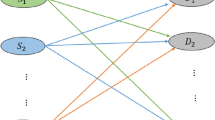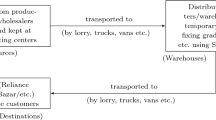Abstract
The main inquisition of this paper is to introduce two methods for solving a multi-objective green 4-dimensional fixed-charge transportation problem (MG4FTP) under neutrosophic environment. The increasing use of transportation vehicles, the condition of roads, vehicle type in daily life to meet our needs that create a lot of problems such as global warming, greenhouse gas (GHG) emissions in the nature. In this paper, we minimize transportation cost, carbon emission and transportation time. In real-life situation, all parameters of transportation problem are not tackled by crisp value, fuzzy numbers and intuitionistic fuzzy numbers, then to accommodate the fact we choice here single valued trapezoidal neutrosophic number (SVTNN) for designing such type of transportation problem. Thereafter we use \(\left( \alpha , \beta , \gamma \right) \)-cut of SVTNN to convert the parameters in interval form of the proposed model. Two new approaches based on neutrosophic programming (NP) and Pythagorean hesitant fuzzy programming (PHFP) are used to extract a better compromise solution of the proposed problem. A comparison is drawn among the compromise solutions that are derived from the programming, by using the score function of SVTNN. Two numerical examples are included to illustrate the applicability and validity of the proposed problem.








Similar content being viewed by others
References
Abdel-Basset M, Gunasekaran M, Mohamed M, Smarandache F (2019) A novel method for solving the fully neutrosophic linear programming problems. Neural Comput Appl 31(5):1595–1605
Adhami AY, Ahmad F (2020) Interactive Pythagorean-hesitant fuzzy computational algorithm for multi-objective transportation problem under uncertainty. Int J Manag Sci Eng Manag 15(4):288–297
Aktar MS, De M, Maity S, Mazumder SK, Maiti M (2020) Green 4D transportation problems with breakable incompatible items under type-2 fuzzy-random environment. J Clean Prod 275:122376
Amirteimoori A (2011) An extended transportation problem: a DEA-based approach. Cent Eur J Oper Res 19(4):513–521
Arya R, Singh P, Kumari S, Obaidat MS (2020) An approach for solving fully fuzzy multi-objective linear fractional optimization problems. Soft Comput 24(12):9105–9119
Atanassov KT (1999) Intuitionistic fuzzy sets. Springer, Berlin, pp 1–137
Bellman RE, Zadeh LA (1970) Decision-making in a fuzzy environment. Manag Sci 17(4):B-141-B-164
Chakraborty A, Mondal SP, Ahmadian A, Senu N, Alam S, Salahshour S (2018) Different forms of triangular neutrosophic numbers, de-neutrosophication techniques, and their applications. Symmetry 10(8):327
Das SK, Roy SK (2019) Effect of variable carbon emission in a multi-objective transportation-p-facility location problem under neutrosophic environment. Comput Ind Eng 132:311–324
Das SK, Roy SK, Weber GW (2020) Application of type-2 fuzzy logic to a multi-objective green solid transportation-location problem with dwell time under carbon tax, cap, and offset policy: fuzzy versus nonfuzzy techniques. IEEE Trans Fuzzy Syst 28(11):2711–2725
Gessesse AA, Mishra R, Acharya MM, Das KN (2020) Genetic algorithm based fuzzy programming approach for multi-objective linear fractional stochastic transportation problem involving four-parameter burr distribution. Int J Syst Assur Eng Manag 11(1):93–109
Ghosh S, Roy SK, Ebrahimnejad A, Verdegay JL (2021) Multi-objective fully intuitionistic fuzzy fixed-charge solid transportation problem. Complex Intell Syst 7(2):1009–1023
Ghosh S, Roy SK (2021) Fuzzy-rough multi-objective product blending fixed-charge transportation problem with truck load constraints through transfer station. RAIRO Oper Res 55:S2923–S2952
Gupta G, Kaur J, Kumar A (2016) A note on fully fuzzy fixed-charge multi-item solid transportation problem. Appl Soft Comput 41:418–419
Haley K (1962) New methods in mathematical programming-the solid transportation problem. Oper Res 10(4):448–463
Hirsch WM, Dantzig GB (1968) The fixed-charge problem. Nav Res Logist Q 15(3):413–424
Hitchcock FL (1941) The distribution of a product from several sources to numerous localities. J Math Phys 20(1–4):224–230
Khalifa HAEW, Kumar P, Mirjalili S (2021) A KKM approach for inverse capacitated transportation problem in neutrosophic environment. Sādhanā 46:166. https://doi.org/10.1007/s12046-021-01682-5
Kumar R, Edalatpanah SA, Jha S, Singh R (2019) A Pythagorean fuzzy approach to the transportation problem. Complex Intell Syst 5:255–263
Lee SM, Moore LJ (1973) Optimizing transportation problems with multiple objectives. AIIE Trans 5(4):333–338
Maity G, Roy SK (2016) Solving multi-objective transportation problem with interval goal using utility function approach. Int J Oper Res 27(4):513–529
Malik M, Gupta S (2020) Goal programming technique for solving fully interval-valued intuitionistic fuzzy multiple objective transportation problems. Soft Comput 24(18):13955–13977
Mardanya D, Maity G, Roy SK (2021) The multi-objective multi-item just-in-time transportation problem. Optimization. https://doi.org/10.1080/02331934.2021.1963246
Mehlawat MK, Kannan D, Gupta P, Aggarwal U (2019) Sustainable transportation planning for a three-stage fixed-charge multi-objective transportation problem. Ann Oper Res. https://doi.org/10.1007/s10479-019-03451-4
Midya S, Roy SK, Vincent FY (2021) Intuitionistic fuzzy multi-stage multi-objective fixed-charge solid transportation problem in a green supply chain. Int J Mach Learn Cybern 12(3):699–717
Mohammed A, Wang Q (2017) The fuzzy multi-objective distribution planner for a green meat supply chain. Int J Prod Econ 184:47–58
Nayeri S, Paydar MM, Asadi-Gangraj E, Emami S (2020) Multi-objective fuzzy robust optimization approach to sustainable closed-loop supply chain network design. Comput Ind Eng 148:106716
Paul N, Sarma D, Bera UK (2019) A neutrosophic solid transportation model with insufficient supply. In: 2019 IEEE region 10 symposium (TENSYMP). IEEE, pp 379–384. https://doi.org/10.1109/TENSYMP46218.2019.8971130
Peng X, Selvachandran G (2019) Pythagorean fuzzy set: state of the art and future directions. Artif Intell Rev 52(3):1873–1927
Pratihar J, Kumar R, Edalatpanah SA, Dey A (2021) Modified Vogel’s approximation method for transportation problem under uncertain environment. Complex Intell Syst 7:29–40
Ringuest JL, Rinks DB (1987) Interactive solutions for the linear multi-objective transportation problem. Eur J Oper Res 32(1):96–106
Rizk-Allah RM, Hassanien AE, Elhoseny M (2018) A multi-objective transportation model under neutrosophic environment. Comput Electr Eng 69:705–719
Roy SK, Ebrahimnejad A, Verdegay JL, Das S (2018) New approach for solving intuitionistic fuzzy multi-objective transportation problem. Sadhana 43(1):3. https://doi.org/10.1007/s12046-017-0777-7
Roy SK, Midya S (2019) Multi-objective fixed-charge solid transportation problem with product blending under intuitionistic fuzzy environment. Appl Intell 49(10):3524–3538
Samanta S, Jana DK, Panigrahi G, Maiti M (2020) Novel multi-objective, multi-item and four-dimensional transportation problem with vehicle speed in LR-type intuitionistic fuzzy environment. Neural Comput Appl 32:11937–11955
Schaffer JR, O’Leary DE (1989) Use of penalties in a branch and bound procedure for the fixed-charge transportation problem. Eur J Oper Res 43(3):305–312
Sengupta D, Das A, Dutta A, Bera UK (2018) A carbon emission optimization model with reduction method of type-2 zigzag uncertain variable. Neural Comput Appl 32:10895–10914
Smarandache F (1999) A unifying field in logics. neutrosophy: neutrosophic probability, set and logic. American Research Press, Rehoboth
Sumathi I, Sweety CAC (2019) New approach on differential equation via trapezoidal neutrosophic number. Complex Intell Syst 5(4):417–424
Thamaraiselvi A, Santhi R (2016) A new approach for optimization of real-life transportation problem in neutrosophic environment. Math Probl Eng. Article ID: 5950747. https://doi.org/10.1155/2016/5950747
Yager RR, Abbasov AM (2013) Pythagorean membership grades, complex numbers, and decision making. Int J Intell Syst 28(5):436–452
Yu VF, Hu KJ, Chang AY (2015) An interactive approach for the multi-objective transportation problem with interval parameters. Int J Prod Res 53(4):1051–1064
Zadeh LA (1996) Fuzzy sets. In: Klir GJ, Yuan B (eds) Fuzzy logic, and fuzzy systems: selectedpapers by Lotfi A, Zadeh. World Scientific, Singapore and River Edge, NJ
Zhang B, Peng J, Li S, Chen L (2016) Fixed-charge solid transportation problem in uncertain environment and its algorithm. Comput Ind Eng 102:186–197
Acknowledgements
The authors are very much grateful to the Editor-in-Chief, Associate Editor and anonymous respective reviewers for their insightful comments that helped us so much to rigorously improve the quality of the manuscript. The author Binoy Krishna Giri is very much grateful to the University Grant Commission of India for supporting financially to continue this research work under JRF (UGC) scheme: Sanctioned letter number [F.NO. 16-9(June 2019)/2019(NET/CSIR)].
Author information
Authors and Affiliations
Corresponding author
Ethics declarations
Conflict of interest
Authors declare that, there is no conflict of interest for preparing the manuscript.
Additional information
Publisher's Note
Springer Nature remains neutral with regard to jurisdictional claims in published maps and institutional affiliations.
Rights and permissions
About this article
Cite this article
Giri, B.K., Roy, S.K. Neutrosophic multi-objective green four-dimensional fixed-charge transportation problem. Int. J. Mach. Learn. & Cyber. 13, 3089–3112 (2022). https://doi.org/10.1007/s13042-022-01582-y
Received:
Accepted:
Published:
Issue Date:
DOI: https://doi.org/10.1007/s13042-022-01582-y




